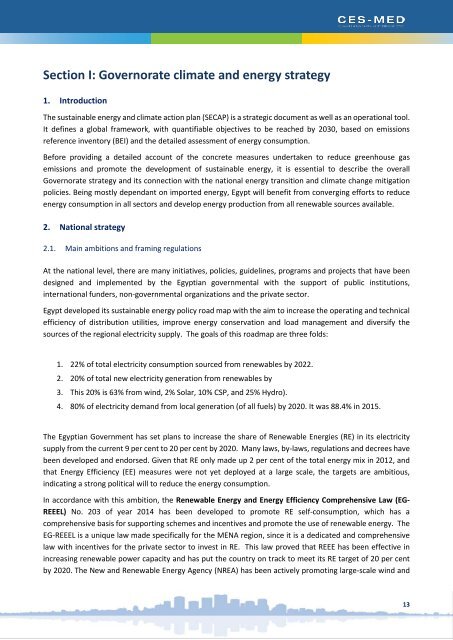280218_Luxor-Egypt SECAP Final_revised
You also want an ePaper? Increase the reach of your titles
YUMPU automatically turns print PDFs into web optimized ePapers that Google loves.
Section I: Governorate climate and energy strategy<br />
1. Introduction<br />
The sustainable energy and climate action plan (<strong>SECAP</strong>) is a strategic document as well as an operational tool.<br />
It defines a global framework, with quantifiable objectives to be reached by 2030, based on emissions<br />
reference inventory (BEI) and the detailed assessment of energy consumption.<br />
Before providing a detailed account of the concrete measures undertaken to reduce greenhouse gas<br />
emissions and promote the development of sustainable energy, it is essential to describe the overall<br />
Governorate strategy and its connection with the national energy transition and climate change mitigation<br />
policies. Being mostly dependant on imported energy, <strong>Egypt</strong> will benefit from converging efforts to reduce<br />
energy consumption in all sectors and develop energy production from all renewable sources available.<br />
2. National strategy<br />
2.1. Main ambitions and framing regulations<br />
At the national level, there are many initiatives, policies, guidelines, programs and projects that have been<br />
designed and implemented by the <strong>Egypt</strong>ian governmental with the support of public institutions,<br />
international funders, non-governmental organizations and the private sector.<br />
<strong>Egypt</strong> developed its sustainable energy policy road map with the aim to increase the operating and technical<br />
efficiency of distribution utilities, improve energy conservation and load management and diversify the<br />
sources of the regional electricity supply. The goals of this roadmap are three folds:<br />
1. 22% of total electricity consumption sourced from renewables by 2022.<br />
2. 20% of total new electricity generation from renewables by<br />
3. This 20% is 63% from wind, 2% Solar, 10% CSP, and 25% Hydro).<br />
4. 80% of electricity demand from local generation (of all fuels) by 2020. It was 88.4% in 2015.<br />
The <strong>Egypt</strong>ian Government has set plans to increase the share of Renewable Energies (RE) in its electricity<br />
supply from the current 9 per cent to 20 per cent by 2020. Many laws, by-laws, regulations and decrees have<br />
been developed and endorsed. Given that RE only made up 2 per cent of the total energy mix in 2012, and<br />
that Energy Efficiency (EE) measures were not yet deployed at a large scale, the targets are ambitious,<br />
indicating a strong political will to reduce the energy consumption.<br />
In accordance with this ambition, the Renewable Energy and Energy Efficiency Comprehensive Law (EG-<br />
REEEL) No. 203 of year 2014 has been developed to promote RE self-consumption, which has a<br />
comprehensive basis for supporting schemes and incentives and promote the use of renewable energy. The<br />
EG-REEEL is a unique law made specifically for the MENA region, since it is a dedicated and comprehensive<br />
law with incentives for the private sector to invest in RE. This law proved that REEE has been effective in<br />
increasing renewable power capacity and has put the country on track to meet its RE target of 20 per cent<br />
by 2020. The New and Renewable Energy Agency (NREA) has been actively promoting large-scale wind and<br />
13

















